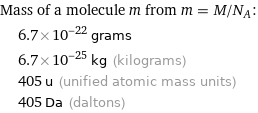Input interpretation

boc-β-iodo-ala-Obzl | molar mass
Result
![Find the molar mass, M, for boc-β-iodo-ala-Obzl: M = sum _iN_im_i Plan: • Write the chemical formula and gather atomic masses from the periodic table. • Determine values for N_i and m_i using these items. • Finally, compute the mass. Write the chemical formula: ICH_2CH[NHCO_2C(CH_3)_3]CO_2CH_2C_6H_5 Use the chemical formula, ICH_2CH[NHCO_2C(CH_3)_3]CO_2CH_2C_6H_5, to count the number of atoms, N_i, for each element: | N_i C (carbon) | 15 H (hydrogen) | 20 I (iodine) | 1 N (nitrogen) | 1 O (oxygen) | 4 Look up the atomic mass, m_i, in g·mol^(-1) for each element in the periodic table: | N_i | m_i/g·mol^(-1) C (carbon) | 15 | 12.011 H (hydrogen) | 20 | 1.008 I (iodine) | 1 | 126.90447 N (nitrogen) | 1 | 14.007 O (oxygen) | 4 | 15.999 Multiply N_i by m_i to compute the mass for each element. Then sum those values to compute the molar mass, M: Answer: | | | N_i | m_i/g·mol^(-1) | mass/g·mol^(-1) C (carbon) | 15 | 12.011 | 15 × 12.011 = 180.165 H (hydrogen) | 20 | 1.008 | 20 × 1.008 = 20.160 I (iodine) | 1 | 126.90447 | 1 × 126.90447 = 126.90447 N (nitrogen) | 1 | 14.007 | 1 × 14.007 = 14.007 O (oxygen) | 4 | 15.999 | 4 × 15.999 = 63.996 M = 180.165 g/mol + 20.160 g/mol + 126.90447 g/mol + 14.007 g/mol + 63.996 g/mol = 405.232 g/mol](../image_source/2c55c0a507e86cf1ade253fd5e698438.png)
Find the molar mass, M, for boc-β-iodo-ala-Obzl: M = sum _iN_im_i Plan: • Write the chemical formula and gather atomic masses from the periodic table. • Determine values for N_i and m_i using these items. • Finally, compute the mass. Write the chemical formula: ICH_2CH[NHCO_2C(CH_3)_3]CO_2CH_2C_6H_5 Use the chemical formula, ICH_2CH[NHCO_2C(CH_3)_3]CO_2CH_2C_6H_5, to count the number of atoms, N_i, for each element: | N_i C (carbon) | 15 H (hydrogen) | 20 I (iodine) | 1 N (nitrogen) | 1 O (oxygen) | 4 Look up the atomic mass, m_i, in g·mol^(-1) for each element in the periodic table: | N_i | m_i/g·mol^(-1) C (carbon) | 15 | 12.011 H (hydrogen) | 20 | 1.008 I (iodine) | 1 | 126.90447 N (nitrogen) | 1 | 14.007 O (oxygen) | 4 | 15.999 Multiply N_i by m_i to compute the mass for each element. Then sum those values to compute the molar mass, M: Answer: | | | N_i | m_i/g·mol^(-1) | mass/g·mol^(-1) C (carbon) | 15 | 12.011 | 15 × 12.011 = 180.165 H (hydrogen) | 20 | 1.008 | 20 × 1.008 = 20.160 I (iodine) | 1 | 126.90447 | 1 × 126.90447 = 126.90447 N (nitrogen) | 1 | 14.007 | 1 × 14.007 = 14.007 O (oxygen) | 4 | 15.999 | 4 × 15.999 = 63.996 M = 180.165 g/mol + 20.160 g/mol + 126.90447 g/mol + 14.007 g/mol + 63.996 g/mol = 405.232 g/mol
Unit conversion

0.40523 kg/mol (kilograms per mole)
Comparisons

≈ 0.56 × molar mass of fullerene ( ≈ 721 g/mol )

≈ 2.1 × molar mass of caffeine ( ≈ 194 g/mol )

≈ 6.9 × molar mass of sodium chloride ( ≈ 58 g/mol )
Corresponding quantities

Mass of a molecule m from m = M/N_A: | 6.7×10^-22 grams | 6.7×10^-25 kg (kilograms) | 405 u (unified atomic mass units) | 405 Da (daltons)

Relative molecular mass M_r from M_r = M_u/M: | 405